HISTORY OF PIPING IN MEDICINE HAT AREA
100 years of pipe band tradition in Medicine Hat in 2012
Early Individual Pipers
It is unknown who the first pipers in Medicine Hat might have been. There were pipers who worked for the Hudson's Bay Company and who travelled the rivers, possibly even the South Saskatchewan. The most famous, Colin Fraser, accompanied Gov. George Simpson on his travels between about 1827 and 1835 and then continued to pipe at his HBC postings, finishing in Fort Chipewyan. His pipes are part of the collection at the Royal Alberta Museum in Edmonton.

Colin Fraser's pipes at Royal Alberta Museum, Edmonton. (Photo: M. Sissons)
A Nova Scotia regiment was stationed in Medicine Hat during the Riel Rebellion (1884-85) and they may have had pipers. Highland regiments were quite popular and both British and Canadian armies had a number of such regiments. Donny White, retired Curator of the Medicine Hat Museum, has a letter from his grand-mother in which she described doing the sword dance at the old NWMP barracks on Police Point in the late 1880's. Some of these old buildings were later moved to the Legion property where the pipe band later practised.
The earliest (c. 1895) piper known by name in the district was James H. Wilson, who farmed north of Hatton in Saskatchewan, east of Walsh. His wife apparently became fed up with the pipes and threw them in the wood stove, thus ending his musical career.
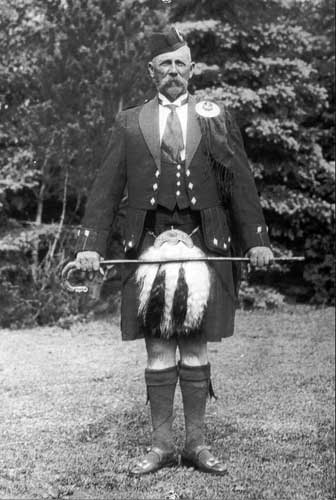 Jimmy Wilson of Hatton (Photo: E. Moch)
Jimmy Wilson of Hatton (Photo: E. Moch)
Another early piper was "Happy Jack Hart" who operated the Elkwater coal mine and lived in a cottage near the lakeshore. He would play his pipes in the evening by the lake. In this photo, he appears to be having a good time with his chums.
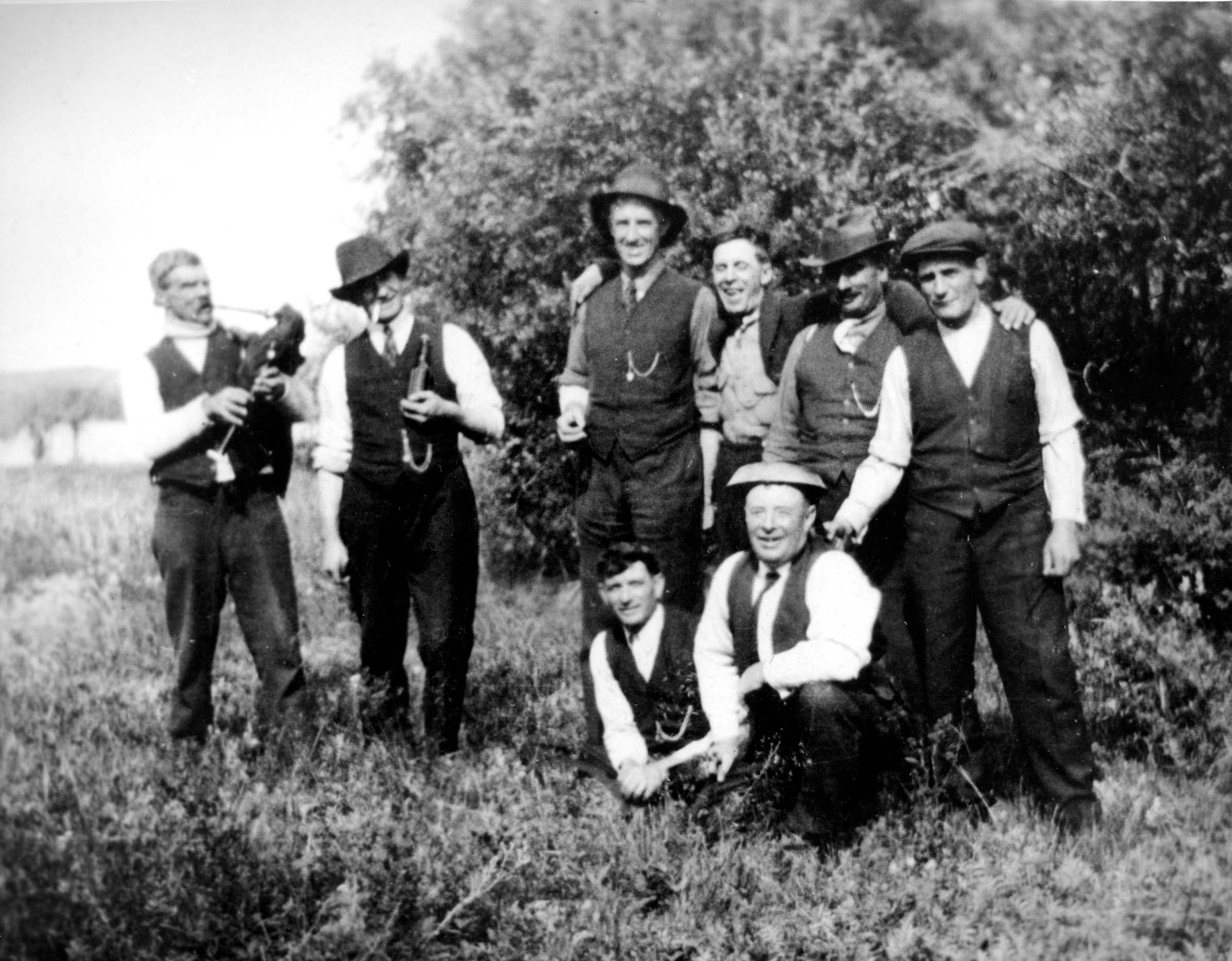
Happy Jack Hart and friends (Photo: Esplanade Archives)
The Beginning of the Band
It seems that there was a band formation in Medicine Hat as early as 1909, perhaps called the "Medicine Hat Kiltie Band". Early pipers included George Garden, recorded as Pipe Major prior to 1912. It is suggested that George's brother Alex screened recruits for the band over in Scotland. It is recorded in the minutes of the Legion that "The Medicine Hat Pipe Band" had been established in Medicine Hat in 1912 and the orginal handwritten constitution from that date is to be found in the Esplanade Archives. It is unclear when or if Pipe Major Garden continued to be Pipe Major after the Medcine Hat Pipe Band was established but Alex Hosie, who haled from Forfar, Scotland, was soon the Pipe Major of this newly established band. He was piping in Scotland by 1900 and served in the Highland Light Infantry. His brother Bill was one of the best pipers in Scotland. In Alex Hosie's obituary, it is stated that he came to Medicine Hat in 1912 "on request of the Medicine Hat Kiltie Band, which he and a group of other men from their native land were asked to join. The Kiltie Band became famous throughout Canada and the United States...". From these two references, it is assumed that a band of some type already had been in existence for about three years. The band certainly did exist from 1912 onward. A newspaper reference records the names of the first pipers and drummers of the band. (Medicine Hat News, 11 May 1912). The tartan at this time was Hunting Stewart, possibly in honour of H. Stewart, President of the Band Society.
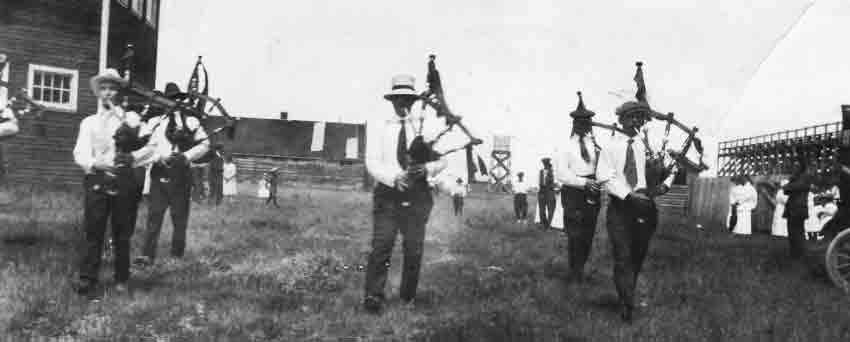
Kiltie Pipe Band of Medicine Hat practising, about 1912. (Photo: Bonnie Fischer)
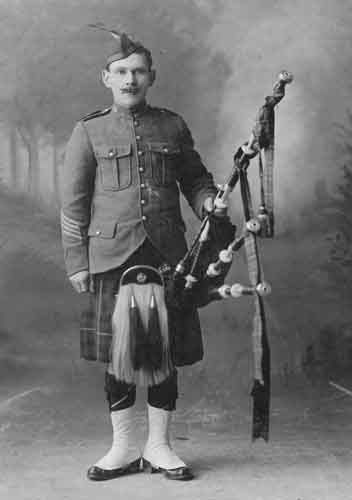 Alex Hosie, Pipe Major, 1916 (Photo: D. Campbell)
Alex Hosie, Pipe Major, 1916 (Photo: D. Campbell)
Alex and the other members of the band signed up in the 113th Battalion, Lethbridge Highlanders, in Lethbridge in 1915. THis regiment was broken up in England and he saw service in Europe with the 17 Seaforth Highlanders (Reserve) and finished the war with the rank of Pipe Major. None of the other members of the Kiltie Band returned to Medicine Hat after the war. The tune "Longueval" that our band plays is named for a monument in France to the pipers who died in the Great War.
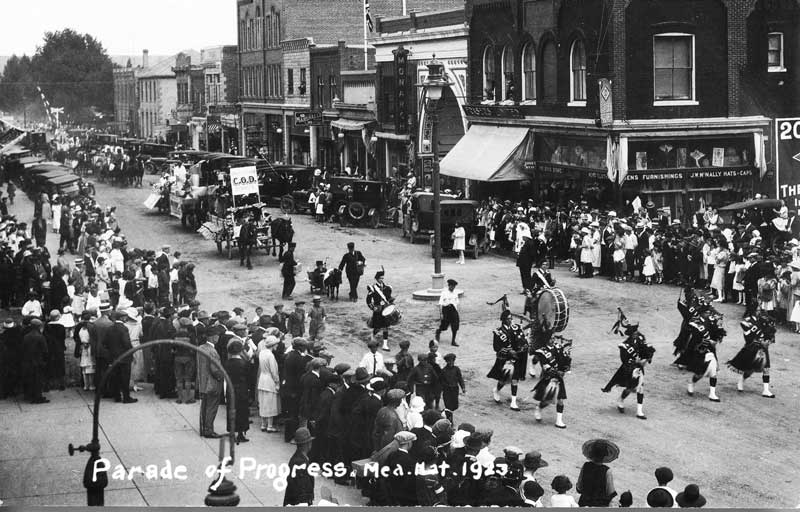
Medicine Hat Pipe Band in parade, 1923. (Photo: Esplanade Archives)
The Legion Affiliation
This band became affiliated with the Canadian Legion of Medicine Hat in 1928, and was called "The Canadian Legion Pipe Band of Medicine Hat".Alex was a champion piper, and also judged at piping competitions held at Banff and Seattle.
.jpg)
Best dressed Highlander competition, Banff, 1920's or 1930's. Hosie in middle. (Photo: B. Fischer)
Alex Hosie worked as a janitor at Elm Street School where chanter and pipe classes were held and he lived next to the school with his family, many of whom were involved with the band. He kept his gear in the boiler room and the band would march up and down in the basement. Pipe Major Hosie used to melt down silver spoons on the school boiler and cast them into ferrules to ornament pipe drones. He retired from the band shortly before 1960.
Some of the earliest names in the band were pipers Alex Hosie, Bill Williamson (ice deliveryman), George McIntosh (policeman), Joe McQueen (Chief of police), and Don Grant (Sr.). Early drummers included bass Len Sharland, lead side drummer Jim Goldie (worked at Olgivie Mill) and Davie Kerr (city worker), who was married to a daughter of Alex Hosie. The band wore full military uniform with the MacGregor tartan. George McIntosh was Pipe Sergeant for decades under Pipe Major Hosie. His son-in-law Joe Bell became quartermaster in the 1960's, and grandchildren Neil, Morag, George and Hazel all played in the band. A great-grandson, Lachlan, attended band school, making for four generations in the band!
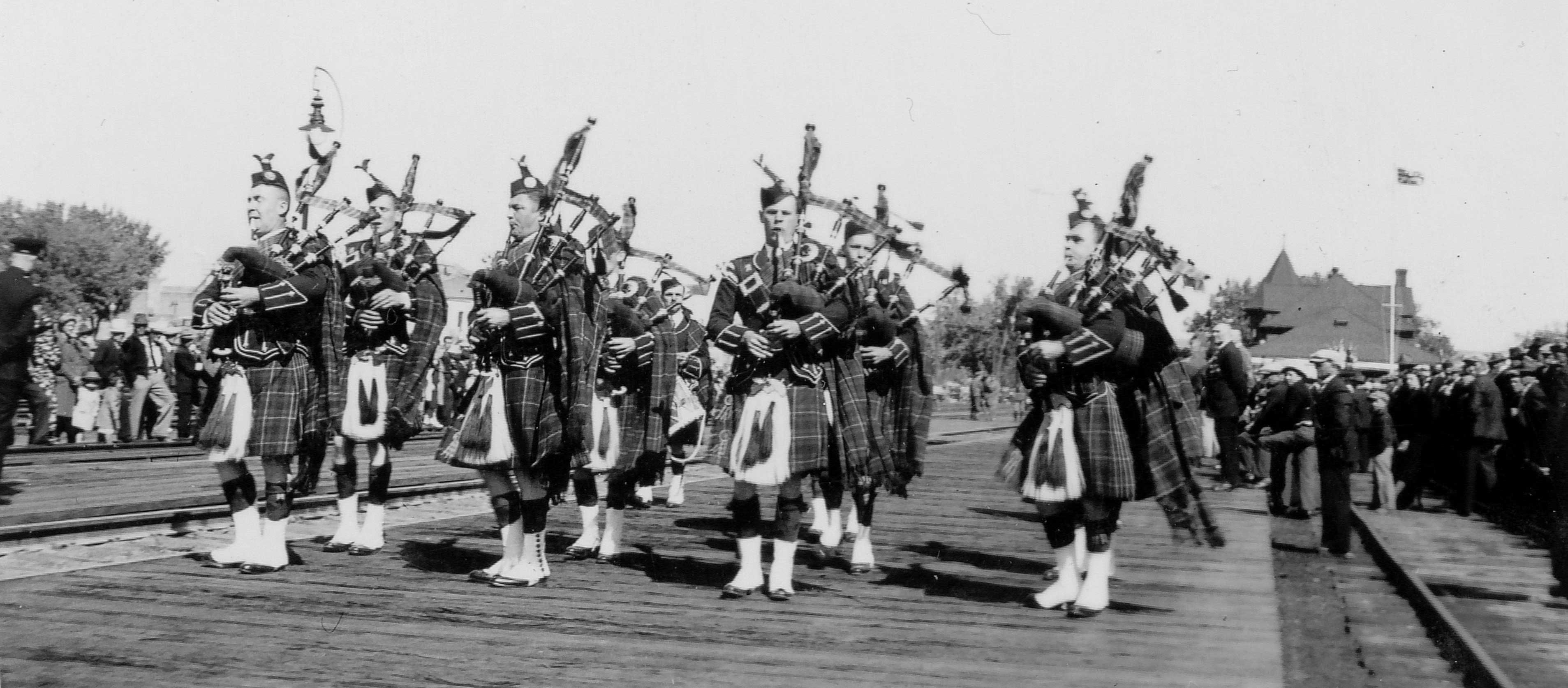
The band plays for the King and Queen during their Royal Tour through Medicine Hat in 1939. Pipe Sergeant George McIntosh on the left. (Photo: Bob Townsend)
In the 1930's, some more names of bandsmen included pipers Ian Fraser (whose father had Fraser's Plumbing), Charlie Bailey, Hector Smith, and Donny MacGregor. Jack and Bill MacGregor, Donny's brothers became drummers. In World War II, Bill Hosie (Alex's son), Bailey and the two MacGregors joined the Calgary Highlanders and saw action in Europe after D-Day. Bill Hosie died in France. Donny MacGregor, who began piping in 1935, played again in the band in the 1950's and again in 2003-2004, a piping career of 70 years!
The Post-War Era
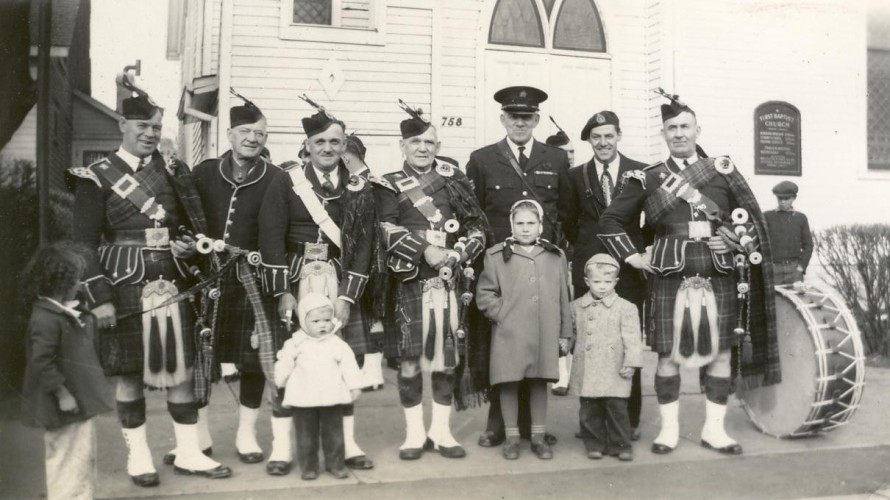
Various pipe band and Hosie family members in front of church, 1949. Pipe Major Alex Hosie in centre (Photo: B. Fischer)
The Medicine Hat branch of the Royal Canadian Legion continued to sponsor a pipe band in the post war period under Pipe Major Alex Hosie. At this time, the band practices were held in the old Legion building, a former NWMP building moved over from Police Point. Donald Grant lived in one building and supervised band practices in the early 1960's while the old barn was used for storage for the Legion and lawn bowling. Born in Glasgow, Grant piped in Scotland before coming to Canada in about 1910, ending up on a farm in the Burstall area where he would play his pipes for the school children at times. He moved to Medicine Hat in about the 1920's and had a long career with the pipe band.
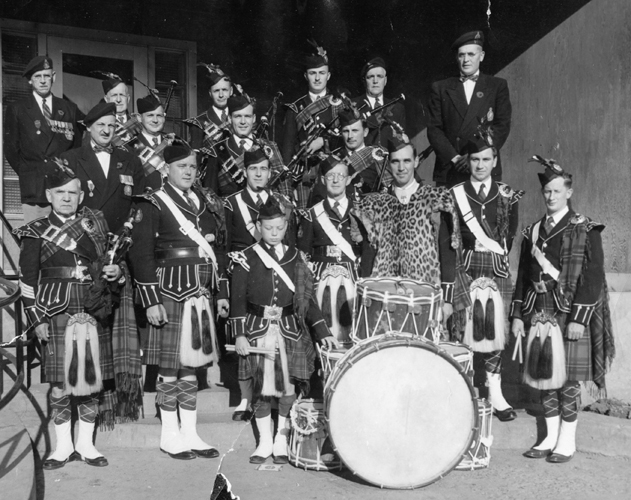
Royal Canadian Legion Pipe Band c.1954. Hosie is in front on left. Grant is back row, second left. (Photo: Royal Canadian Legion, Branch 17)
In about 1958 or 1959, Alex Hosie retired as the Pipe Major and Bill Cowan took over the position. Willy Cowan, as he was called by his father, began piping as a young man in his native Fife, Scotland, and played in competitive pipe bands from Dumferline and Kinross in Scotland before emigrating to Canada in 1957. He acted as Pipe Major in the Medicine Hat Legion pipe band and the South Alberta Pipe Band until he retired from the position in 1978 after about 20 years although he stayed on as treasurer for a couple more years.
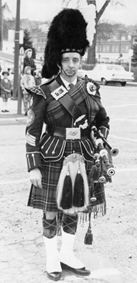 Bill Cowan, Pipe Major, 1959 (Photo: M. Cowan)
Bill Cowan, Pipe Major, 1959 (Photo: M. Cowan)
The South Alberta Pipe Band
The South Alberta Pipe Band was founded in 1966 when most of the members left the Medicine Hat Legion band which subsequently folded. The tartan and hat badge used were those of Clan MacDuff but only because of preference of the band members for that tartan. The Chief of Clan MacDuff granted his permission to use the tartan and cap badges (letter since lost). Full military tunic, plaid, glengarries and feathered bonnets, spats, horsehair sporrans composed part of the original uniform.
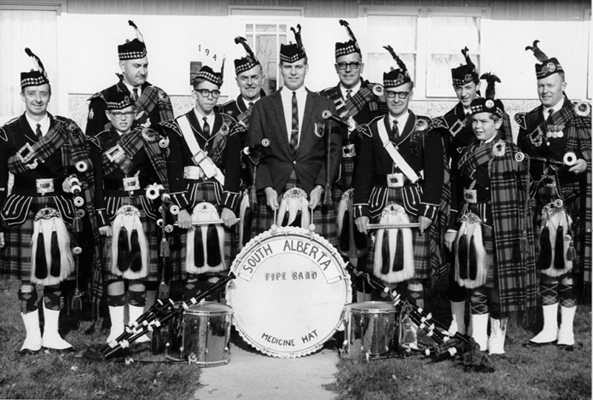
South Alberta Pipe Band c. 1967 (Photo: M. Cowan)
When Bill Cowan retired from the South Alberta Pipe Band, Fred Standing became Pipe Major in 1978, followed by Ron Shannon in 1979 (who started the school format as it is today) and then Fred Standing again in 1980 before the position was taken over by Eric Kean (who had joined the band in 1975) in 1981.
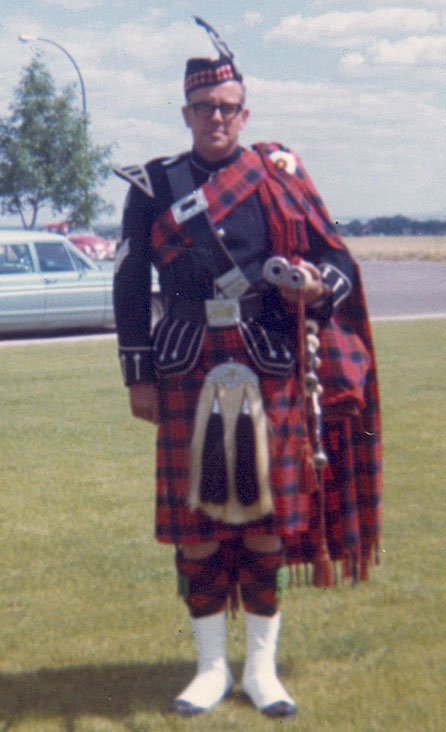 Fred Standing, Pipe Major (Photo: F. Standing)
Fred Standing, Pipe Major (Photo: F. Standing)
Fred was in the Legion band and helped form the South Alberta Pipe Band. He lived in Red Deer from 1971-75 but rejoined the band upon his return to Medicine Hat. A highlight of Fred's career was being PM during the Alberta Winter Games, held in Medicine Hat in 1978, with a gala performance in the arena with the Armstrong Singers.
Ron Shannon began piping in 1954 and played with the Prescott Highland Pipe Band and the Brockville CNRA Highland Pipe Band. In1970, Ron was recruited to become Pipe Major of the Spencerville Legion Highland Pipe Band and retained this position for 5 years until moving to Medicine Hat in 1975, when he joined the SAPB. Ironically, his first parade with the SAPB was the last parade for PM Bill Cowan. In the SAPB, he became the Pipe Corporal and in the fall of 1979 became the Pipe Major of the SAPB. Unfortunately, for work related reasons, he stepped down in the fall of 1980 as Pipe Major.
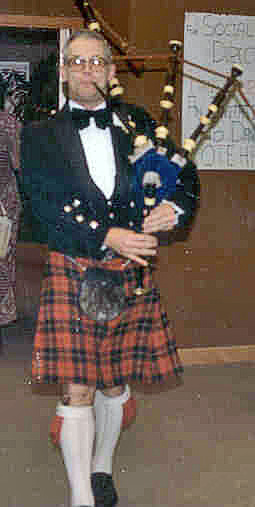 Pipe Major Ron Shannon, 1980, playing in Banff. (Photo: R. Shannon)
Pipe Major Ron Shannon, 1980, playing in Banff. (Photo: R. Shannon)
The Band under P/M Eric Kean
Eric Kean was born and raised in Edinburgh (but was not a piper there) and came to Medicine Hat in 1975. Eric lived close to Ron Shannon and heard him play, which inspired him to take up the pipes. When Ron Shannon stepped down as Pipe Major, Eric took over and has been Pipe Major ever since.
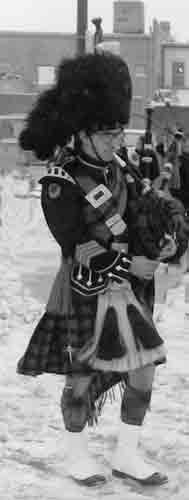 Eric Kean, Pipe Major at Remembrance Day ceremony, early 1980's (Photo: E. Kean)
Eric Kean, Pipe Major at Remembrance Day ceremony, early 1980's (Photo: E. Kean)
The band became a registered society in 1977 and during the 1980's performed regularly, even participating in the organization of a Highland Games in Medicine Hat. During the late 1970's and 1980's, the band became very much of a family affair, with many pipers and drummers being children of adult band members. About 1980, the band switched to the current style of uniform with balmorals, Argyll jackets, plain leather sporrans but continued with the MacDuff tartan.
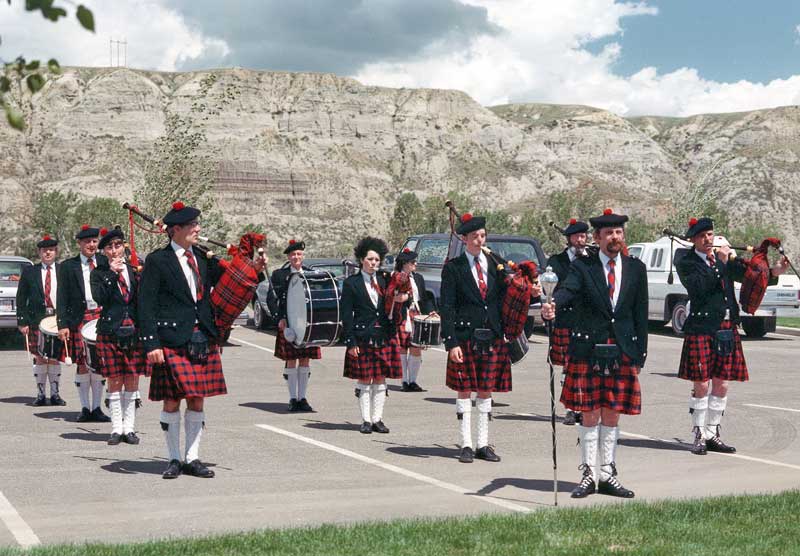
Echodale Park Opening Ceremonies, 1980, in new uniforms. (photo: City of Medicine Hat)
In the late 1990's, band membership dwindled as the children grew up and moved away. The society was stricken from the corporate registry in 1997, although Eric Kean and Bob Colley and a small group of students kept up individual performances and band school activities.
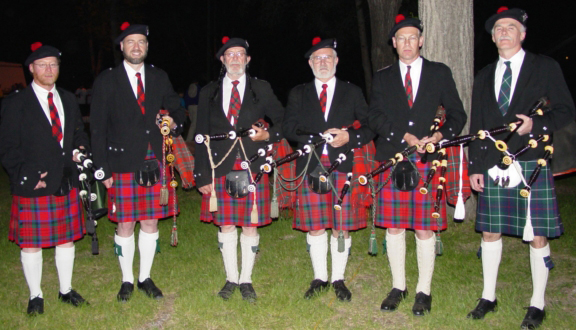
Relay for Life 2003. No drummers at this time. (Photo: M. Sissons)
New members joined several years later and in 2003, public band performances and parades were again undertaken. In addition to Eric and Bob, some former members rejoined the band: Mike Spencer, Mike Campbell, Jack Schweitzer, Malcolm Sissons. Several students graduated from the band school to take up positions as pipers and drummers. In 2004, a decision was made to again register as a society, this time as the South Alberta Pipes and Drums Society.
The band plays throughout southern Alberta and northern Montana. Eric Kean continues as Pipe Major, and the band now consists of a number of pipers and drummers.
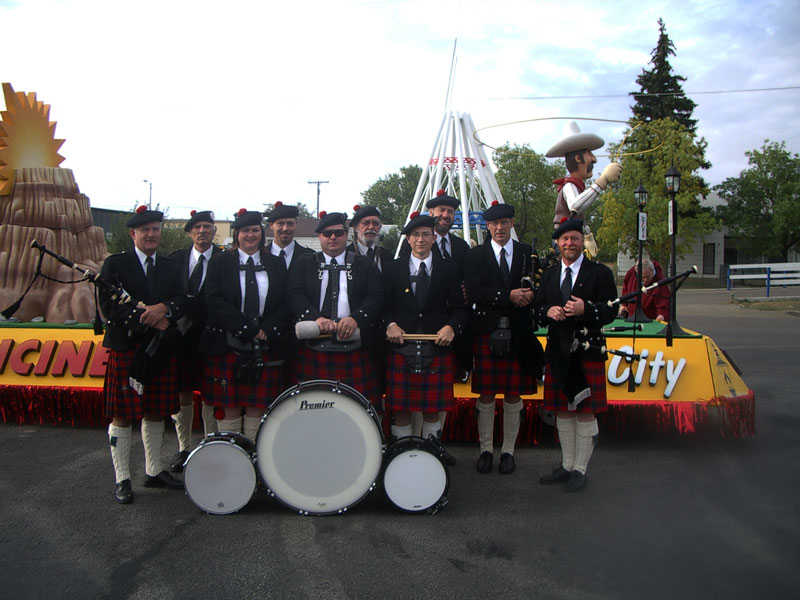
An annual trip to Havre to play in the parade has been a tradition since at least the 1950's. This photo was taken at the start of the 2005 parade. (Photo: M. Sissons)
Note: The clan MacDuff (in the Gaelic MacDhuibh) is of ancient Pictish origin and the chief was Earl of Fife. In earlier times, the MacDuffs had the privilege of crowning the King of Scots and leading the Scottish army. The motto "Deus Juvat" means "God Assists" in Latin. (and some practice nights could be translated as "God help us!")

The band before the 2010 Medicine Hat Stampede Parade (Photo: C. Townsend)
The Moose Girls' Pipe Band
The Moose Girls' Pipe Band was formed about 1961 with Jim Kosmyck as Pipe instructor and Len Sharland (Jr.) as Drum instructor. Kosmyck had previously played pipes and drums with the Calgary Highlanders and when he moved to Medicine Hat, was a bass drummer in the Legion band going back into the Alex Hosie era. When Kosmyck had to leave town for work related reasons in 1968, piper Walter Hogg took over as Pipe instructor and Jack Schweitzer as Drum instructor in 1969. After several more years, Hogg left in 1971 and since another Pipe instructor could not be found, the Moose Girls' Pipe Band folded in 1972.
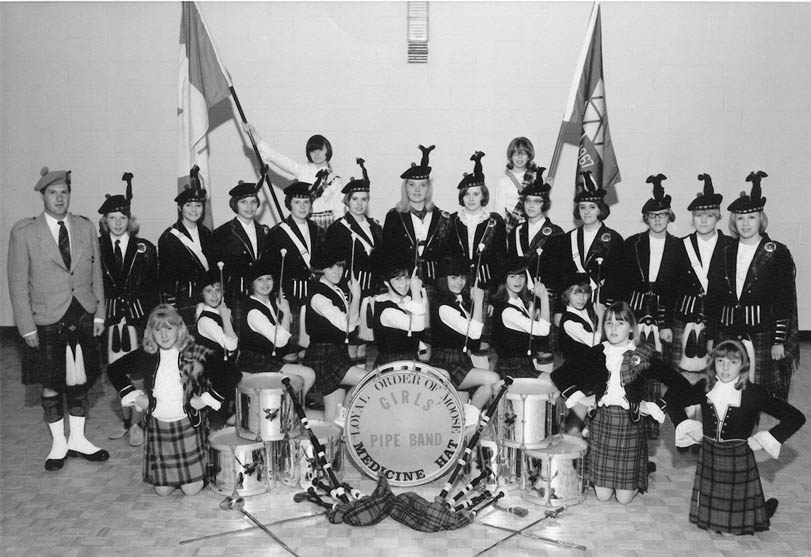
Moose Girls Pipe Band, 1966 (Photo: G. Bollinger)